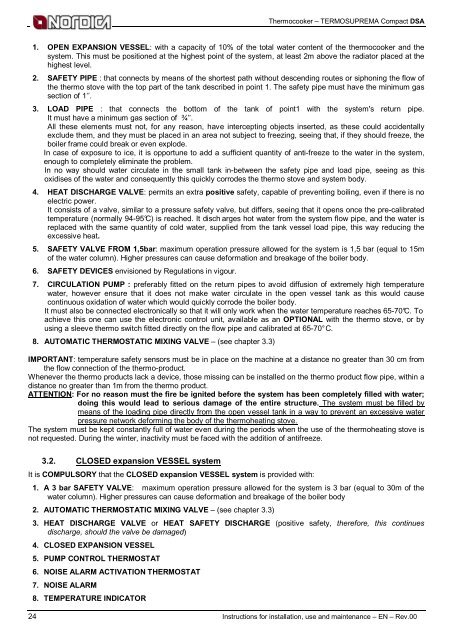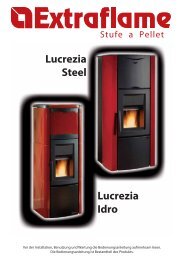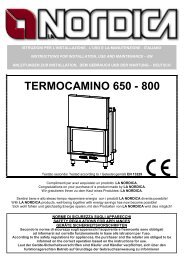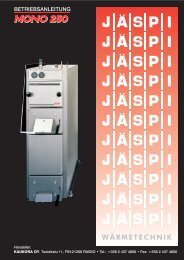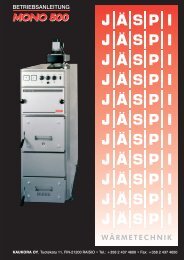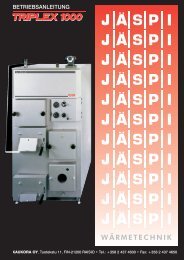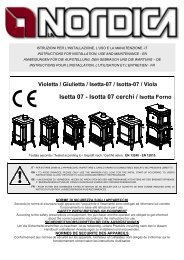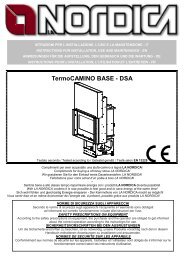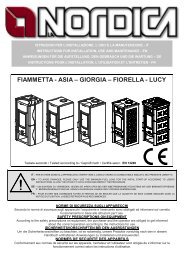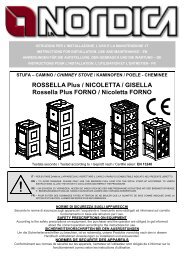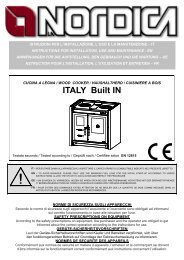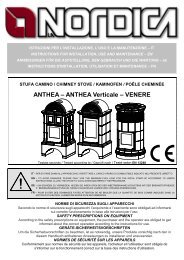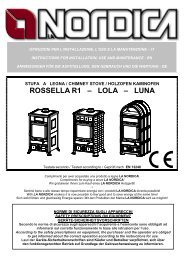TERMOSUPREMA Compact - DSA
TERMOSUPREMA Compact - DSA
TERMOSUPREMA Compact - DSA
Create successful ePaper yourself
Turn your PDF publications into a flip-book with our unique Google optimized e-Paper software.
Thermocooker – <strong>TERMOSUPREMA</strong> <strong>Compact</strong> <strong>DSA</strong><br />
1. OPEN EXPANSION VESSEL: with a capacity of 10% of the total water content of the thermocooker and the<br />
system. This must be positioned at the highest point of the system, at least 2m above the radiator placed at the<br />
highest level.<br />
2. SAFETY PIPE : that connects by means of the shortest path without descending routes or siphoning the flow of<br />
the thermo stove with the top part of the tank described in point 1. The safety pipe must have the minimum gas<br />
section of 1’’.<br />
3. LOAD PIPE : that connects the bottom of the tank of point1 with the system's return pipe.<br />
It must have a minimum gas section of ¾’’.<br />
All these elements must not, for any reason, have intercepting objects inserted, as these could accidentally<br />
exclude them, and they must be placed in an area not subject to freezing, seeing that, if they should freeze, the<br />
boiler frame could break or even explode.<br />
In case of exposure to ice, it is opportune to add a sufficient quantity of anti-freeze to the water in the system,<br />
enough to completely eliminate the problem.<br />
In no way should water circulate in the small tank in-between the safety pipe and load pipe, seeing as this<br />
oxidises of the water and consequently this quickly corrodes the thermo stove and system body.<br />
4. HEAT DISCHARGE VALVE: permits an extra positive safety, capable of preventing boiling, even if there is no<br />
electric power.<br />
It consists of a valve, similar to a pressure safety valve, but differs, seeing that it opens once the pre-calibrated<br />
temperature (normally 94-95°C) is reached. It disch arges hot water from the system flow pipe, and the water is<br />
replaced with the same quantity of cold water, supplied from the tank vessel load pipe, this way reducing the<br />
excessive heat.<br />
5. SAFETY VALVE FROM 1,5bar: maximum operation pressure allowed for the system is 1,5 bar (equal to 15m<br />
of the water column). Higher pressures can cause deformation and breakage of the boiler body.<br />
6. SAFETY DEVICES envisioned by Regulations in vigour.<br />
7. CIRCULATION PUMP : preferably fitted on the return pipes to avoid diffusion of extremely high temperature<br />
water, however ensure that it does not make water circulate in the open vessel tank as this would cause<br />
continuous oxidation of water which would quickly corrode the boiler body.<br />
It must also be connected electronically so that it will only work when the water temperature reaches 65-70°C. To<br />
achieve this one can use the electronic control unit, available as an OPTIONAL with the thermo stove, or by<br />
using a sleeve thermo switch fitted directly on the flow pipe and calibrated at 65-70° C.<br />
8. AUTOMATIC THERMOSTATIC MIXING VALVE – (see chapter 3.3)<br />
IMPORTANT: temperature safety sensors must be in place on the machine at a distance no greater than 30 cm from<br />
the flow connection of the thermo-product.<br />
Whenever the thermo products lack a device, those missing can be installed on the thermo product flow pipe, within a<br />
distance no greater than 1m from the thermo product.<br />
ATTENTION: For no reason must the fire be ignited before the system has been completely filled with water;<br />
doing this would lead to serious damage of the entire structure. The system must be filled by<br />
means of the loading pipe directly from the open vessel tank in a way to prevent an excessive water<br />
pressure network deforming the body of the thermoheating stove.<br />
The system must be kept constantly full of water even during the periods when the use of the thermoheating stove is<br />
not requested. During the winter, inactivity must be faced with the addition of antifreeze.<br />
3.2. CLOSED expansion VESSEL system<br />
It is COMPULSORY that the CLOSED expansion VESSEL system is provided with:<br />
1. A 3 bar SAFETY VALVE: maximum operation pressure allowed for the system is 3 bar (equal to 30m of the<br />
water column). Higher pressures can cause deformation and breakage of the boiler body<br />
2. AUTOMATIC THERMOSTATIC MIXING VALVE – (see chapter 3.3)<br />
3. HEAT DISCHARGE VALVE or HEAT SAFETY DISCHARGE (positive safety, therefore, this continues<br />
discharge, should the valve be damaged)<br />
4. CLOSED EXPANSION VESSEL<br />
5. PUMP CONTROL THERMOSTAT<br />
6. NOISE ALARM ACTIVATION THERMOSTAT<br />
7. NOISE ALARM<br />
8. TEMPERATURE INDICATOR<br />
24 Instructions for installation, use and maintenance – EN – Rev.00


